Homes. Since the early dawn of man, we have tried to perfect the four walls around us and our families (or early on – the caves around us). Depending on where you stand on the spectrum of creationists, darwinists and ancient-alienists, you might believe in slighty different timescales since the dawn of man – but regardless of your viewpoint, we are talking thousands of years (plus) since the dawn of man.

So, you’d think: Hey, in thousands of years, we should have perfected “the home”.
Well, I don’t think we have. At least not yet.
Today, news broke about 011h's €25M Series-A, led by our good friends Harald, Mira and their team at Redalpine, and with participation from Breega, Seaya and several other great backers.
We had co-led 011h's €8M seed round in December 2020, and are proud to continue backing Lucas and the team with fresh money as part of this massive raise.
In our view, 011h (en: zero eleven aitch) is finally perfecting homes. Not decoration, not optics, not shiny vanity penthouses for millionaires. But how rapidly and how clean and at-cost we can industrialize multi-family homes for the broad population across Europe.
011h is a radically scalable platform for multi-family homes in Europe to develop fast – and most important – at lower cost, at quality and with net-zero carbon.
Flush with cash now, let’s see wood TF the crew at 011h is doing to revolutionize multi-family homes.
Oh, and spoiler alert – if you read carefully, you might also find somewhere wood TF the name 011h stands for 🥸
In construction, we historically find two types of contractors:
There are A/EPC firms – which stands for architecture/engineering, procurement and construction. These firms assume a construction project from soup to nuts. A/EPC firms house a wide skillset – from specialists who design and run engineering calculations, to purchasing teams, and of course most importantly, construction managers, site managers. In some cases, A/EPC firms are further integrated as self-performing, which means they have construction workers and on-site engineers performing actual construction trades. Depending on how vertically specialized the A/EPC has become, some even conduct development, permitting and financing parts of the value-creation. Examples of some of the largest A/EPC firms are Technip, Hyundai Heavy Industries, Samsung (yep), or Fluor.
The other type is what’s more commonly known as a general contractor (GC): They accept the general responsibility to deliver the outcome of the construction project on time – and thus assume and buffer commercial risks – and to acquire and coordinate the required skills, manpower along the project schedule. A GC’s value creation often starts after the development and financing is done by someone else, and most GCs on the planet are not self-performing. That means, most GCs have the model to find sub-contractors to deliver manpower for specific jobs on the project (eg. electric works, plumbing works) and to acquire parts of the materials.
While A/EPCs have a very wide value-creation – they are much rarer and much more specialized. Classic GCs on the other hand, have a more narrow value set – but make up the majority in the market.
What you might have noticed is that with the many GCs out there – the A/E + P parts (and even some C parts) are outsourced to sub-contractors and consultants.
And that’s unfortunately how the vast majority of projects and homes in the world are being delivered …
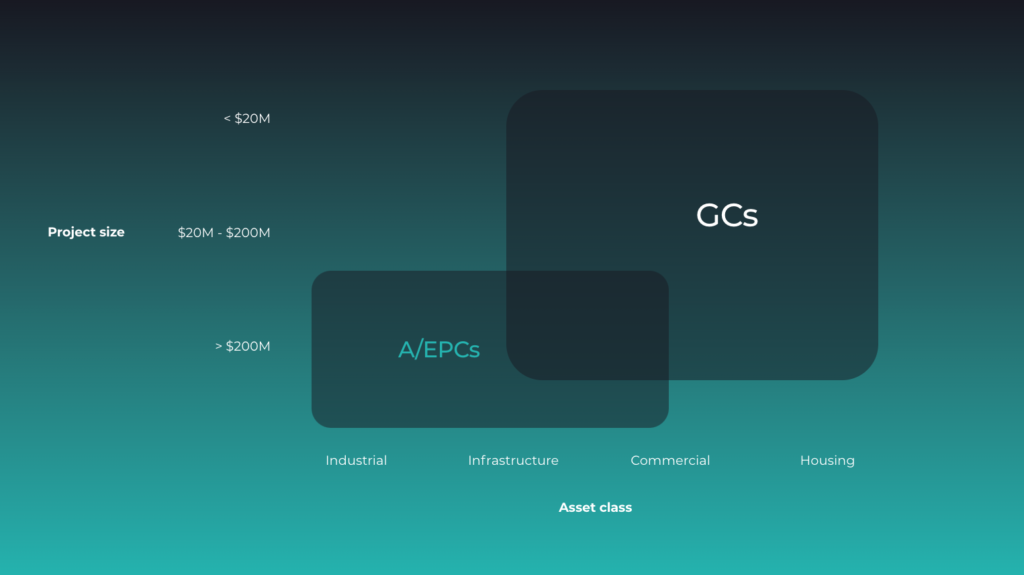
If you’ve read our data on CO2 last year, you recall that 17% of the world’s carbon emissions unfortunately are caused by construction. Seven teen purr cent.
So, let’s overlay the CO2 data in a super non-scientific way and see where the majority of carbon emissions from construction sit:
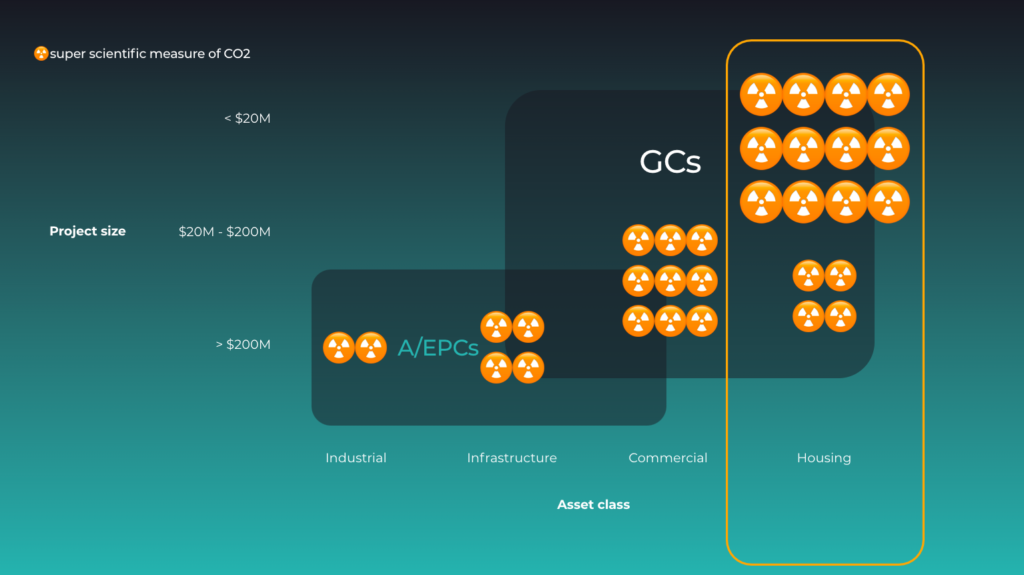
As you can see: Housing projects done by GCs offer a lot of carbon avoidance potential.
So Wood TF does all this have to do with 011h? Everything.
In Europe, other than the US for example, building multi-family homes with concrete+steel is the norm in many markets.
While concrete is by far not as damaging to the environment as some headlines suggest, the sheer amount of concrete volume is posing a massive opportunity to reduce emissions. After all, concrete is the second most consumed substance in the world after water. It is an amazingly scalable and cost-effective material.
We are big believers that we should shoot for silver bullets, but not rely on a single silver bullet, to fix the built world’s emissions. And we better do it very quick.
Therefore, we are excited to back firms that help solve concrete’s carbon footprint and maintain volumes of low-emission concrete – and we are equally excited to partner with founders who complement the world’s concrete use through other scalable, and equally cost-effective, net-zero building methods.
👆 This is where Lucas, Jota and the 011h crew come in.
011h is
011h’s core software stackNow, you might think: So what? There was a particular off-site construction company (Katerra) who raised more than $3B and claimed to transform construction by becoming automotive-like in their production.
The thing with firms like Katerra was: they never were automotive-like in the first place. A modern automotive OEM is the opposite – it designs and engineers a certain car model platform (a building stack), prescribes the drivetrain, chassis, electronics and all other components (windows, walls, plumbing and electric). It then qualifies and binds a network of suppliers on these prescribed designs and components.
What a modern automotive OEM keeps inhouse is (i) the software (ii) final assembly of all components, (iii) the supplier network and (iv) brand and distribution and aftermarket. That makes an automotive OEM a platform – a scalable platform – and not an asset-heavy factory. The likes of Katerra never were automotive-like in the first place for that reason – they were not a platform.

011h is an asset-light construction platform that resembles the automotive OEM platform approach.
(i) In its core, 011h is a stack of self-developed construction management and supply chain management software (on top of which certain market/off-the-shelf software is integrated). Each supplier and sub contractors to 011h's building projects gets qualified and onboarded onto the core software stack, and has to work with and deliver into the software.

011h’s software stackTheir software stretches from building design with a fully integrated BIM down to the atomic object level (a screw head, its production cost and CO2 footprint – no joke – for a screw head …), and expands all the way to the frontline execution where workers on-site are fed with eg. touchscreens to have standup meetings to discuss the placing of the screw head on the ground.
This became possible because 011h has designed standardized building models fully in BIM, and has onboarded all its suppliers to the model and the software.
(ii) The 011h team controls all assembly on site, informed by its software that runs the supply chain, and the on site teams.
(iii) For each component (eg. windows, bathrooms, walls etc), 011h has built a massively scalable platform of qualified and vetted partners across Europe that pre-manufacture and deliver according to 011h‘s prescribed design specs. The partners work into the core software stack for manufacturing lead times, quality and delivery. Everything is centralized in the stack.
(iv) Automotive OEMs benefit from massively scalable distribution channels, selling to millions of consumers. However, it remains a closed platform – “my brand, my rules”. Differently, 011h‘s platform is open to housing developers. This provides inherent scalability – every multi-family developer across Europe is becoming able to develop on top of the 011h platform, net zero, at lower cost.
👆 These four items are what make automotive OEMs a platform. And it’s what makes 011h the equivalent in construction of homes – a truly scalable platform. But open.
011h‘splatform is open to housing developers. This provides inherent scalability – every multi-family developer across Europe is becoming able to develop on top of the011hplatform, net zero, at lower cost.
The reason why we fell in love with that model is not just the model, and the vast opportunity in a home-starved European market. It is an opportunity ripe for CO2 reduction, too.
But most importantly, we fell in love with the team.
Building a platform business is never easy. Doing it in the ops-intensive built-world, where you need really scalable supply chains, is taking the challenge up two notches. For that reason, we waited patiently to partner with an amazing team of founders who’ve “been there, done that”:
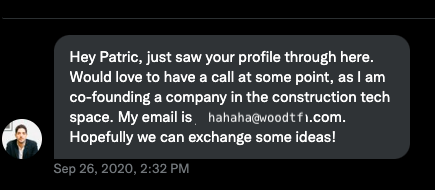
We are uber privileged that José and team felt it worthwhile talking to us back in 2020, which culminated in us co-leading their Seed financing in December, alongside amazing co-investors Greg Dewerpe, Giuseppe Zocco, Manel Adell and many others.
Now, 1.5 years and €25M of new funding later, we get to expand this amazing platform and rockstar team into the stratosphere.

011h stands for? Look no further: The name derives from the first 3 sequences of the Fibonacci cycle (0-1-1) while the aitch represents humans in a healthy habitat. Boom – zero eleven aitch. Easy to remember, lots to think about. And great to show up top of every alphabetical list.The first order of business is to maximize the digital industrialization of multi-family homes in Spain. 011h has built a track record of delivering its first homes on time and below cost. It has an ambitious pipeline of several hundred of units to be constructed in 2022 alone.
With that track record, growing across Spain is a logical fast next step.
Expanding the open-ness of the platform is a major opportunity – by opening the platform to new developers and suppliers.
And who knows, maybe at that point new asset classes such as single-family homes will become net-zero and truly scalable with 011h, too. The sky will be the limit, since construction really really really needs scalable solutions to build millions of homes across Europe with net-zero emissions. 🚀 🧑🚀 🍀.
P.S. If you love 011h, be sure to check out our other rockstar Digital GCs in the US – Juno (using timber for multi-family homes) and Mighty Buildings (using a unique clean material for single and multi-family homes).
3D design. Somehow everyone seems to have an idea of what it is. But it’s like the offside rule in soccer – if someone asks you to explain it, things become tricky for the casual viewer.

As Investors, we have been excited about 3D for a while. It can be a humongous opportunity for founders. As evidenced by the team and the amazing community at Speckle, who today broke news about their $6.5M seed round co-led by Frontline and Matrix Partners, and a host of amazing angels such as the co-founders of Sentry, Plangrid, Built Technologies and many other friends. We had led Speckle’s pre-seed round in 2020 and are excited to finally lift the curtain on what we think is one of the hottest tech companies in 3D. So let’s talk 3D.
Up until a few months ago, not many people outside the experts cared much about it. And then something happened recently which made talking about 3D design a lot more relevant to a lot more people: the metaverse. Sounds like a curve ball, let me explain…
The media attention the metaverse has received shed light on the incredible technological development related to the 3D world such as, ever-improving graphics processing units (GPUs), photorealistic 3D engines, and faster content generation through volumetric video. In other words, it substantiated a claim we had been excited about, for some time:
That our world runs on 3D.
2D has been in the investment news for the past decade – with Figma, Canva, Miro, more recently Pitch and the likes, breaking funding headlines. So you could say – investors haven’t really appreciated the potential of 3D until recently.
Well: the importance of 3D is no news to the architecture, engineering and construction (AEC) industry, where the potential for 3D design has been supported by a community of architects and 3D designers over the last five decades.
And yes, every tool needs a craftsman. Architects are able to indulge in their design visions, while engineers are able to build more complex, geometrical structures than ever before. We believe creators can expand their relevance even further, as we rely on 3D design technologies to enable us to build with less **wasted materials and more creativity.
And yet, with all its massive potential, 3D design has been a crazy pain in the 🍑 for architects, gaming developers, media and movie designers, and everyone else who uses 3D software. Let’s call them 3D creators.
The pain that 3D creators experience is diverse and comes in many forms. We’ve found that most of the root causes fall into one of the following five buckets:
1/ Vendor silos and lack of interoperability
3D software is a mishmash mix of authoring tools and specialty software. All of them need a full or partial 3D model to interact with. So you would think: hey, if they all use the same kind of model, it should be quite open? Well, let me tell you: it’s not. In fact, it’s the opposite. Tons of vendors are building 3D software. A few selected ones have done a bunch of acquisitions of smaller 3D point-solutions to integrate. What those silos do is create vendor lock-ins and disallow interoperability. Amongst other things, this results in unsynced data between software silos and a loss of meta information from one software to the other (eg. change logs, access rights, time stamps).
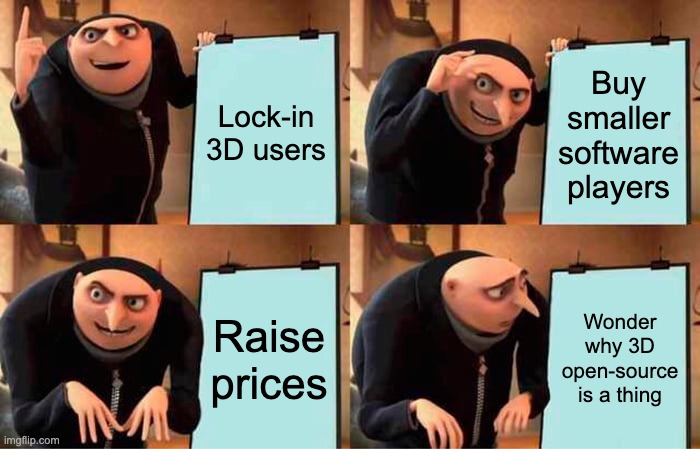
2/ File-bound
So when we say that all 3D software run on the same kind of model, you’d think those models are properly normed and standardized. Bad luck, they’re not. A bunch of file formats – some proprietary, some more generally adopted – are in use. But the worst part is: it’s FILES. It’s big, unstructured, opaque blobs of 300+ megabytes that 3D creators have to store, send around, upload in order to share and collaborate. Terrible idea to have 3D run on big blobs of files. The result? Long and manually tedious file sharing download and upload times, and you never find the one granular object you need to work on easily.
3/ No true multiplayer – 3D is play-by-email at factor 300x
Which leads me to the fact that 3D creators are essentially single-players playing a multi-player in the play-by-email (PBEM) format. Any readers here old enough to remember PBEM ? If yes it means you’ve been around in the 80s and 90s and sending saved-games to your buddies (like me) when you finished your turn, and then your buddy loads your saved-game to run their turn, and so on. PBEM is the amount of multiplayer we have today in 3D. It’s a crazy disaster, because we 3D creators PBEM with 300+ megabyte large blob-files – which are not just way too large, but they never contain exactly the information that my multiplayer buddy needs. Maybe my co-creator only needs certain objects (eg. columns, windows, pipes) to run their analysis on. But the reality is: I have to send them my entire big-blob model because the file does not allow me to properly structure and filter down to send them only the objects that they need. For instance, an architect makes a conceptual change that the engineer in another firm then has to translate into engineering. Every single change leads to multiple iterations, which makes the software silos even more unbearable. 3D today comes without multiplayer. It is PBEM.
4/ On-prem is still a thing
One of the most dazzling oxymorons of the 3D software space is that on one hand, the software are highly sophisticated pieces able to run complex operations, but on the other hand so backwards and unsophisticated that many of them still run on-premise. The move towards cloud and subscriptions – while underway for many years – is surprisingly slow and laggard here. While we don’t have an exact number, our anecdotal guesstimate is that 50%+ of software is still on-prem. Quite frankly, I wouldn’t be surprised if a fair share of vendors still distribute their 3D software on CD-ROMs, like this gem here.
5/ 3D is exponentially more complex
Finally, all of the root causes above are powered by one first principle: that 3D operations are exponentially more complex than 2D. It is more complex on the software engineering side – which means that 3D authoring tools have a crazy-high minimum feature set to actually add value for the creator. In Figma, you maybe need a dozen or so features. In a 3D authoring tool, you need hundreds to thousands of features to make sense for the creator. And that makes 3D also more complex on the user-side – in order to master authoring tools plus the hundreds of point-solutions and specialty software, a user has to have thousands of hours of training and experience operating the software. 3D is exponentially more complex than 2D.
3D without Speckle is like play-by-email at factor 300x
That’s the reality we live in today. Before we move forward in time and see how Speckle fixes all this – let’s do the scenic route and move back in time. What the f happened to get us into this 3D mess?
Ever heard of computer-aided design (CAD)?
Despite well-known inefficiencies, the AEC industry has not evolved without some technological wins. One particular and early-days technological breakthrough which had eradicated many design errors and drastically improved accuracy in the construction industry are CAD systems. CAD refers to the use of computer systems in assistance of the creation, modification, and analysis of a design.
In the past, calculations used to be performed by hand. CAD offered a truly revolutionary change by taking over that burden. The system did not eliminate any department of draftsmen, engineers and designers, rather, it empowered departments and merged them, ensuring a more efficient and streamlined engineering process.
CAD started 60 years ago (yep, you heard that right)
Let’s dig into a brief history of CAD:

And developed over the past decades into a standard tool for creators
Since the early dawns of the digital age in the 80s and 90s, creators became able to purchase CAD software that runs on personal computers. In fact, there are now more than 6,000 design software just for the construction industry currently.
CAD has become part of any standard academic curriculum around the globe. No architect or engineer designing buildings or products would be crazy enough to live without CAD. That’s how ubiquitous it has become.
However, in spite of how long CAD has been around – and how ubiquitous it is among 3D creators – some community members have made the case that maybe vendors lack incentive to truly solve the root issues with their 3D software. Why would they? The way things are are very profitable for them, with one example making $3.5B in gross profit with a 90% gross profit margin last year.
The old way prints dollars for them. All while their 3D software remain shackled and fairly single-player. So it’s about time for a superior solution to evolve the way we do 3D.
Which leads us to why we think that Speckle is the first true game-changer in 3D design for the past 60 years…
For us, our Speckle-verse journey started with a typical Dimitrie-esque charming email:
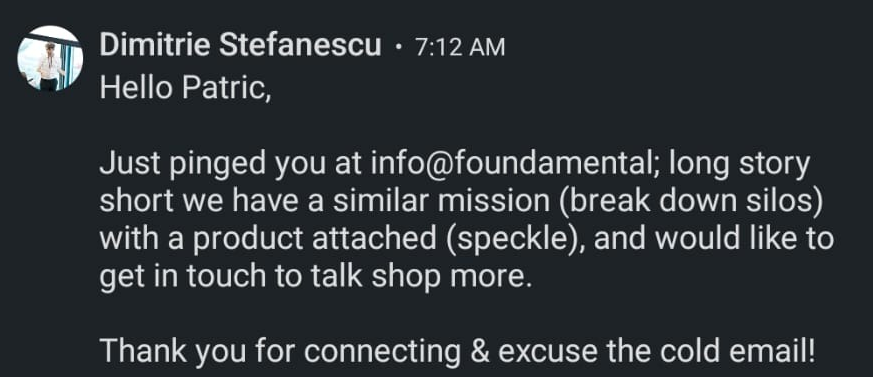
We read the deck, and got in front of Dimitrie and Matteo the same day. While the business was pre-seed and pre-revenue at the time – the product was in its infant stages – but the tech had tons of promise. What was visible in that first chat right away was the founders’ passion for 3D and their hate of the status quo. It became glaringly obvious that this was a case of two founders on a mission.

It took us about 30 minutes after the call to ring Dimitrie and Matteo back up, and ask them to come to our Europe-office in Berlin right away. Which, gladly for us, they accepted. We met a few days later and spent 6 hours workshopping around an open-source go-to market, product strategy, technology edge, hiring plans, and equity story for future raises. Boy, it was inspiring.
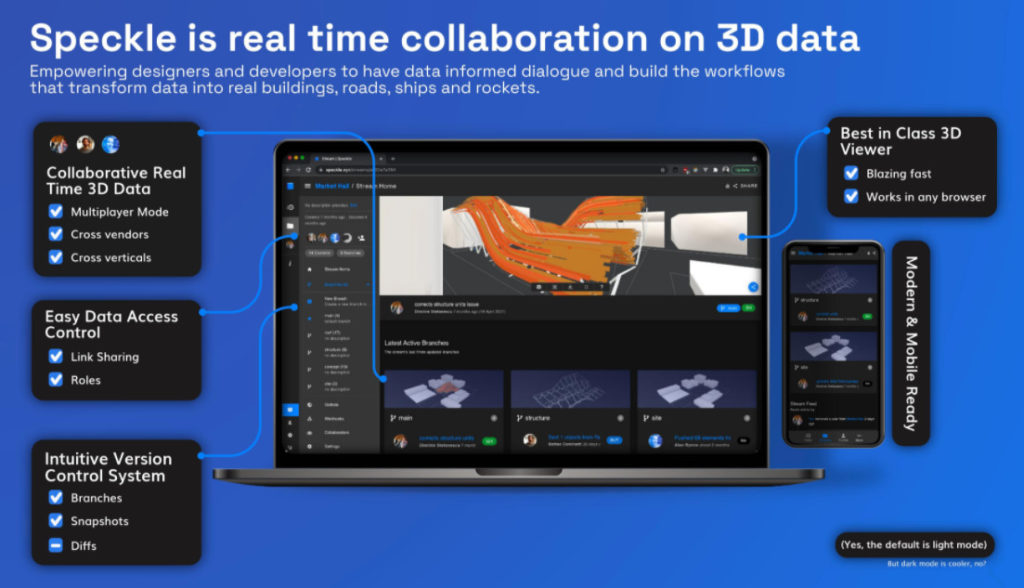
What we learnt from the time spent with Dimitrie and Matteo is that they can be incredibly fun to work with and are instant fan-favorites. While humble and confident enough to say out loud what they don’t know, they had strong and fact-based convictions about things they knew. It was a real fireworks of problem-solving, at the end of which, we already had the intuition that we wanted to do something here to partner with them.
We all shared the key values about Speckle – most importantly, the community-first and open-source approach.
While Dimitrie and Matteo agreed to do some more work – mostly around technical details such as refining their ops model and the hiring plan – we secretly were already in love. It was one of those times when you knew you want to eventually marry that other person after your second date, but you play it cool and distant enough to stay attractive and not scare them away with your “hey I’m easy to get” eagerness.
We had the feeling at this point that the key ingredients that would unlock Speckle to become a wild success seemed in place:
Hindsight is always 20-20, but in this case, I am stupid enough to admit: it really was glaringly obvious that the ingredients are near-perfect.
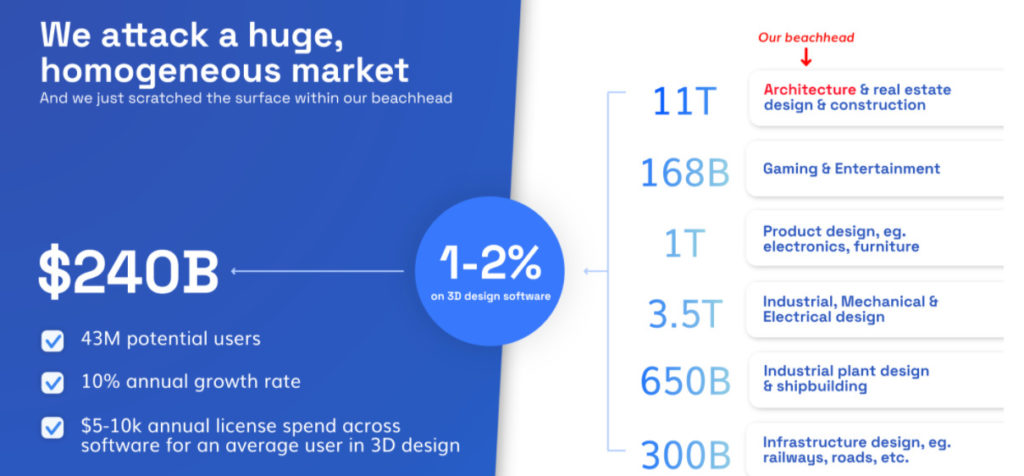
So all we had to agree on at that point was how to execute.
No need for us to come up with a good explanation. Take it straight from the data room from Speckle’s seed round:

The analogy we used in the data room describes Speckle surprisingly well (though sells it waaaaaay short). The underlying tech is powered by a scalable multi-backend object graph persistence system. Think of it like git, but for in-memory objects. It maintains the structure and semantics of original objects, which is key for complex 3D models consisting of hundreds of thousands of objects.
Dimitrie’s original research found a scalable way to decompose objects in their atomic components, in the way that creators, developers or designers define them in their model, as they build.
Speckle then stores and normalizes the object data in a proprietary manner with some secret-sauce that allows to access and distribute the objects either structurally – eg. via GraphQL – or flat where required. But in any case: structured.
This secret sauce unlocks open inter-operability and true multi-player.
Here you are seeing two creators collaborating on the same model from two remote places in two different 3D software at the same time. One creator works on the model in Rhino, the other works in Revit. The left creator updates her 3D model, the right creator receives her updated 3D model in real-time. Speckle stores the version history, the commits, allows comments, and everything else as a full-blown Git for 3D.
While the tech is amazing and highly differentiated, what makes Speckle so powerful goes beyond the tech. Speckle is a streamlined workflow tool with which creators + non-technical users (eg. their clients, their department heads) collaborate, curate and decide on 3D data in real-time.
We learnt from working with Dimitrie and Matteo that 3D creators, engineers, developers, architects, designers are a vast technical community around the globe, with tens of millions of creators. We estimate anecdotally that around 15% of 3D creators are technical – i.e. they can write sophisticated code. And that number is only increasing from here.
More importantly, the community-dynamics are such that creators tend to hate the old ways. Remember above how we spoke about legacy 3D vendors creating lock-ins and squeezing users? Well, turns out creators don’t find that very funny, and they are united as a community against it. Take this small example.
The disconnect and non-interoperability that some legacy vendors actively drive is only solvable via a true open-source project. That’s what we believe.
We also believe that grassroots-up is a highly efficient form of distribution for 3D creators – who spend days in front of their screen, who exchange best practices in discords, forums on twitter and in slack channels very, very frequently and across the global borders.
So when Dimitrie and Matteo pitched us that Speckle MUST be open-source – we fully bought-in within minutes (true story). And all creators backing the Speckle community, all partners such as us alike, believe the same thing – that Speckle will drive 3D multi-player and breaking the 3D shackles BECAUSE Speckle is open-sourced and backed by an amazing technical community spanning the globe and huge in size.
3D becomes FreeD because Speckle is built open-source.
Speckle has made unbelievable progress since mid-2020:
That said, we can’t be satisfied. While the tech that Dimitrie and Matteo invented is incredible, the mission is to move 3D to become FreeD. Ultimately, we partnered with Speckle to support them to break the shackles of 3D vendor lock-ins.
3D will only grow from here, and our entire world will ultimately run on 3D. To be fair, when we first met Dim and Matteo, we did not use the term Metaverse (and I hate it to this day), but it was already clear in the built-world, industrial-world and gaming realms back then, and has only grown stronger.
We believe that 3D is quickly becoming the next design frontier (much bigger than just the metaverse) where users will expect multiplayer features they’ve grown accustomed to from 2D successes, such as versioning, commenting, real-time collaborative edits.
Where we are going, 3D runs the entire world in a free and multi-player way, without fencing and lock-ins, and definitely without clunky blobs of files.
The world we envision is powered by a decentral and democratic community of free 3D creators, with the power to create anything with each other in real-time and unconstrained. That’s what we call FreeD.
And Speckle unlocks FreeD.
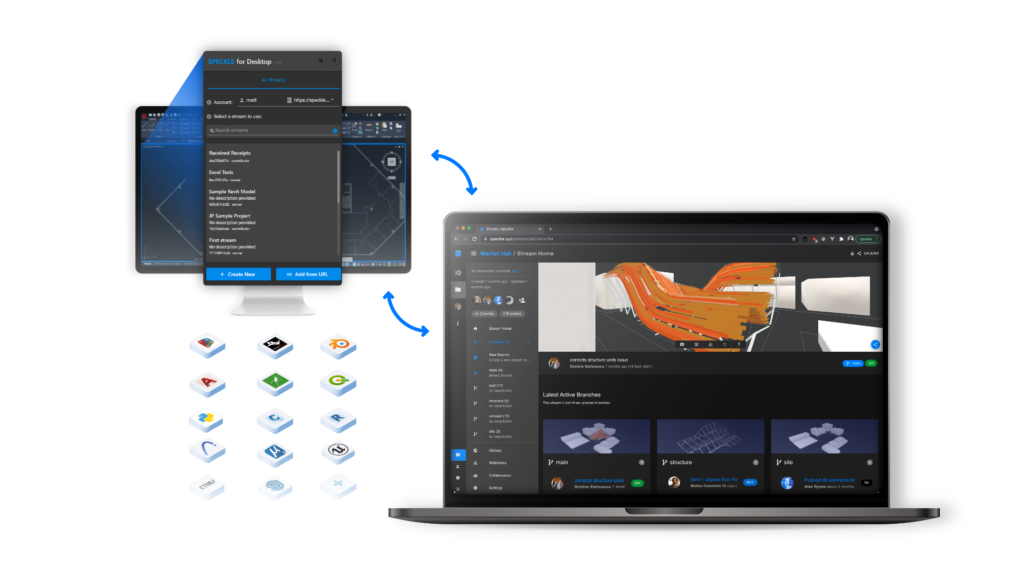
Thank you Dimitrie, Matteo, and the entire community for making Speckle so f*** awesome 🟦 💙
If you are a 3D creator, and hate the old ways – hop over to Speckle and join the community, or drop Dimitrie and Matteo an old-fashioned email.
And if you are a founder in 3D or 2D, we’d love to hear from you ! 💌
Berlin/San Francisco/Singapore, February 25, 2021 – Foundamental, the largest global investor in construction technology, today announced that Infra.Market, a technology firm they invested in early on, has raised $100 million in its Series C funding, making it the first construction tech unicorn in South/Southeast Asia. The round, Foundamental participated in, was led by Tiger Global, with the other existing investors Accel Partners, Nexus Venture Partners, Evolvence India Fund, and Sistema Asia Fund also investing.
“Infra.Market has built not just the market-leader in the space of procurement for construction, but created an entirely new playbook for manufacturing & distribution of materials, a $200+ Billion market with significant tailwinds. In the process, they have also consistently delivered a rare, best-in-class combination of growth and profitability. We are incredibly proud to be a part of their story”, says Shubhankar Bhattacharya, General Partner at Foundamental and responsible for their Asia Pacific investments.
Infra.Market was founded by Souvik Sengupta and Aaditya Sharda in 2016. They offer a one-stop shop for construction materials and products, combining an asset-light procurement and distribution network with a curated supply chain of manufacturers.
“We are digitally transforming the highly inefficient construction materials supply chain in India by aggregating the capacity of small manufacturers and adding our cutting-edge technology and services stack. We are seeing rapid acceleration in demand as infrastructure and real-estate companies are looking to shift their procurement to get consistent quality and minimise delays”, explains co-founder Souvik Sengupta.
Infra.Market is only the 6th construction-specific unicorn so far and the first of its kind in South/Southeast Asia. “If anyone needed further proof here it is: construction tech is inflecting big time. Infra.Market is the fastest unicorn we have seen so far and a telling proof that new and tech-based business models succeed in construction. It also shows that construction tech is truly global and has left behind its US focus”, Bhattacharya adds.
About Foundamental
Foundamental is the largest global investor in construction technology. We recognize global opportunities across markets, from Asia-Pacific over to Europe to North America, and partner with exceptional founders from the earliest stages throughout their venture life cycle. Follow us on LinkedIn and Twitter, or on www.foundamental.com.
About Infra.Market
Infra.Market is an India-based technology company trying to change the way construction and real estate companies procure material for their projects. We are ushering in the next normal in construction: Reshaping the world’s largest ecosystem through technology – every process and every product. We are 300+ strong and headquartered in Mumbai. With centers across India, we have regional offices in Noida, Gurugram, Delhi, Kochi, Bangalore, Hyderabad, Pune, and Nashik. www.infra.market
Barcelona/Berlin, December 14, 2020 – Foundamental, the largest global investor in construction technology, today announced that it has co-led a €10M Seed financing for 011h, a next-generation tech-enabled general contractor for high-quality, affordable and sustainable multi-family homes based in Europe. The company uses technology for the design and construction of sustainable, healthy, and affordable residential buildings. The round is among the ten largest Seed rounds in Europe in 2020.
“We are drawn to founders who fix the general contracting issue with full-service models built around an integrated tech and supplier stack and with sustainable supply chains”, says Patric Hellermann, General Partner at Foundamental.
Lucas Carné, co-founder and co-CEO of 011h, believes “there is a common denominator between all the investors that have put their faith in us. They’re innovative, socially responsible and share our vision of 011h as the best opportunity to revolutionize a sector that they know well.”
José Ojeda, co-founder and COO, notes that “our success will be to achieve a radical transformation of the construction industry we know today into a sector which is more industrial, collaborative, technological, efficient, transparent, and sustainable.” Ojeda added: “Furthermore, the transformation of the industry will help create a range of high-quality homes at affordable prices.”
In the founding team Carné (Privalia) and Ojeda (Lyst, GFG) are joined by José Manuel Villanueva and Josep Barbera (Privalia, Mango), Juan Velayos (Neinor Homes, Renta) and Alex Valls (Social Point).
Over the past 9 months, Foundamental observes a new type of tech-enabled general contractors and home developers in major markets such as the USA, India, Indonesia and now also Europe. Different from earlier companies such as Katerra, who follow an asset-heavy approach, Foundamental observes a shift to asset-light contracting models. Since January 2020, Foundamental estimates that more than $200M of early-stage funding were invested into tech-enabled home-builders. “We see an inflection”, says Hellermann.
011h marks the sixth investment globally that Foundamental has made into tech-enabled home-builders in Asia, North America and Europe. The team’s previous investments in the space include Mighty Buildings, Welcome Homes, and Brick & Bolt.
As to why Foundamental made 011h its first tech-enabled home-builder to back outside Asia and North America, Patric Hellermann said: “The team delivered big successes in home building, supply chain optimization and consumer plays. Their expertise transfers well to build multi-family homes cleaner and faster with their unique platform approach. We are proud to partner with one of the most accomplished founder teams in Europe.”
Foundamental is joined by co-investors A/O PropTech, Giuseppe Zocco, the co-founder of Index Ventures, and Cultivate, the Angel Network founded by Blossom Capital.
About Foundamental
Foundamental is the largest global investor in construction technology. We recognize global opportunities across markets, from Asia-Pacific over to Europe to North America, and partner with exceptional founders from the earliest stages throughout their venture life cycle. Follow the firm via LinkedIn and Twitter, or on www.foundamental.com.
About 011h
011h is a new-generation construction company. The company is revolutionizing the construction industry by using technology to build high-quality smart buildings and create healthy, sustainable lives. Founded in 2020, with an end- to-end construction model, 011h aims to lead the digitalization and industrialization of the construction sector to achieve reduced costs and timescales and greater reliability. 011h’s philosophy relies on the establishment of a new model of collaboration within the construction industry, based on transparency and focusing on people. More on www.011h.com.
About A/O PropTech
A/O PropTech, founded in early 2019 by Swiss entrepreneur Gregory Dewerpe, is the largest Proptech VC firm in Europe, with a current €250mn evergreen capital fund which invests in technology companies transforming real estate into a more digital, efficient, and accessible asset class, by applying innovative technologies and business models. More on www.aoproptech.com.
About Cultivate
Cultivate is an Angel Network made up of founders and operators from European Unicorns, founded by Blossom Capital, and looking to back the most exceptional European Founders. More on www.cultivate.capital.
This Press Release was originally published on PR Web.